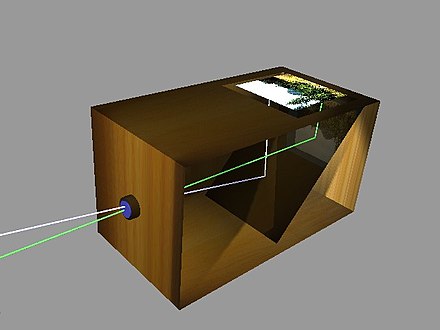A camera obscura (Latin: "dark chamber") is an optical device that led to photography and the photographic camera. The device consists of a box or room with a hole in one side. Light from an external scene passes through the hole and strikes a surface inside, where it is reproduced, rotated 180 degrees (thus upside-down), but with color and perspectivepreserved. The image can be projected onto paper, and can then be traced to produce a highly accurate representation. The largest camera obscura in the world is on Constitution Hill in Aberystwyth, Wales.
Using mirrors, as in an 18th-century overhead version, it is possible to project a right-side-up image. Another more portable type is a box with an angled mirror projecting ontotracing paper placed on the glass top, the image being upright as viewed from the back.
As the pinhole is made smaller, the image gets sharper, but the projected image becomes dimmer. With too small a pinhole, however, the sharpness worsens, due to diffraction. Most practical camera obscuras use a lens rather than a pinhole (as in a pinhole camera) because it allows a largeraperture, giving a usable brightness while maintaining focus.




kayseri escort - hatay escort
ReplyDelete